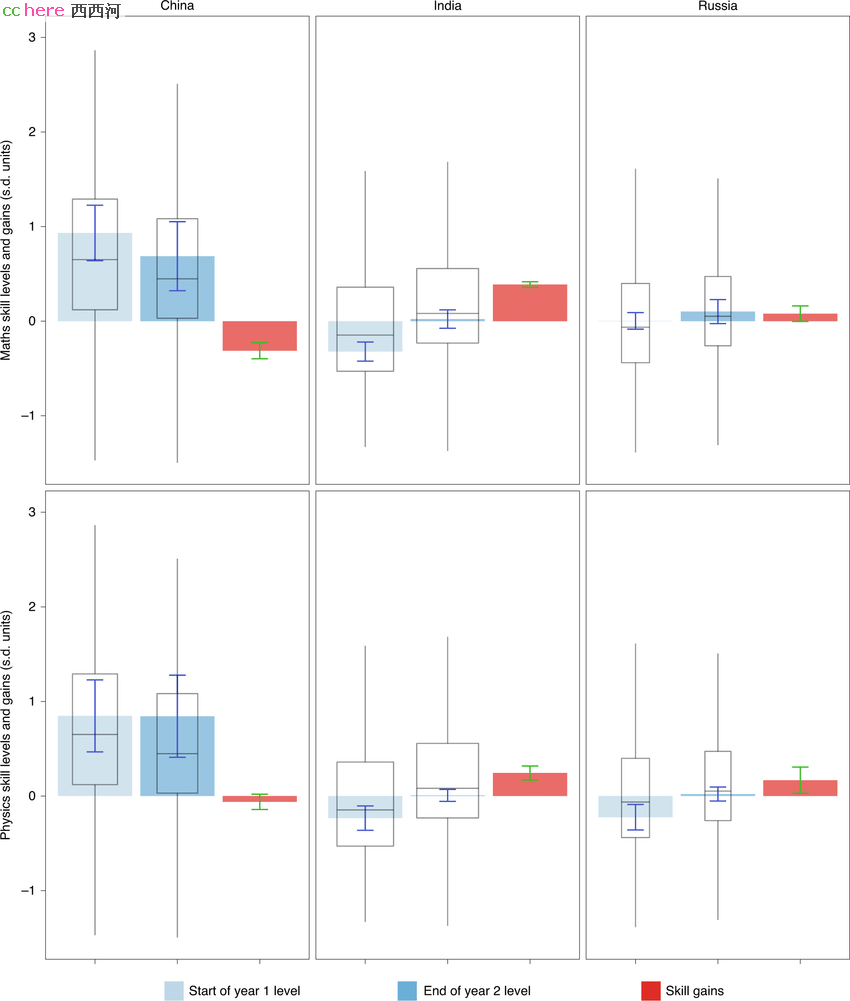主题:从自然子刊的一篇文章看教育的不同,对问题的解决和看法影响 -- 实话实说
2021年3月自然的子刊《人类行为》刊登了一篇文章,Skill levels and gains in university STEM education in China, India, Russia and the United States (试着翻译一下:“中印俄美理工科教育对学生技能发展和知识获得的影响”, 这里主要使用的是意译的方法)这篇文章主要根据跟踪统计四国的计算机科学和电子工程专业学生在物理、数学和批判性思维能力等方面的进步进行研究的结果。
下面是文章参加被研究人员的来源地。
Graduate School of Education, Stanford University, Stanford, CA, USA. 2Freeman Spogli Institute for International Studies, Stanford University, Stanford, CA, USA. 3Educational Testing Service, Princeton, NJ, USA. 4International Center for Action Research on Education, School of Education, Henan University, Henan, China. 5Institute of Education, National Research University Higher School of Economics, Moscow, Russia. 6Center for Studies in Higher Education, Goldman School of Public Policy, University of California Berkeley, Berkeley, CA, USA. 7Faculty of Education, Sichuan Normal University, Sichuan, China. 8Institute of Higher Education Research, University of Jinan, Jinan, China. 9Graduate School of Education, Peking University, Beijing, China. 10Institute of Education, Tsinghua University, Beijing, China. 11World Bank, Washington, DC, USA
共有3万学生参加了这个跟踪考试的过程,作者的来源可以参看以下引用。
(1) Sampling in China, India, and Russia: We sampled computer science (CS) and electrical engineering (EE) major students that, taken together, comprise a large proportion of STEM undergraduates in China (34%), India (24%), and Russia (24%). We first identified all undergraduate (bachelor’s degree) CS and EE programs from China, India, and Russia that had comparable course requirements and content with undergraduate CS and EE programs in the United States. Using the population frame of all higher education institutions with these undergraduate CS and EE programs, we then randomly sampled institutions from these countries. Briefly, from China, we took a simple random sample of six institutions from each of six representative provinces. In India and Russia, we took stratified national random samples of 50 and 34 universities, respectively. Altogether, we sampled 7 elite and 29 non-elite institutions in China, 8 elite and 42 non-elite institutions in India, and 6 elite and 28 non-elite institutions in Russia. For more information about the sampling of institutions, see the SOM. We next randomly sampled administrative units within the sample institutions. In each randomly selected administrative unit, we sampled all first year (freshmen) and third year (junior) students. We randomly assigned half of the students in each year to take grade-specific math and physics exams, one quarter of the students to take a critical thinking exam, and one quarter of the students to take a quantitative literacy exam. Response rates in the baseline were high with 95% of enrolled students taking the exams in China, 95% in India, and 87% in Russia. Altogether, 5,102 freshmen and 4,145 juniors from China, 8,232 freshmen and 9,223 juniors from India, and 2,607 freshmen and 2,096 juniors from Russia participated. We conducted follow-up testing after almost two years with the different subsets of freshmen and junior students from the baseline (when they were at the end of their sophomore and senior years). Freshmen that had taken math and physics tests in the baseline took end-of-year 2-appropriate math and physics test in the follow-up, while freshmen and juniors that took critical thinking in the baseline took the critical thinking test in the follow-up. Response rates in the follow-up were again relatively high with 80% of enrolled students taking the exams in China, 95% in India, and 90% in Russia.
To ensure national representativeness, we adjusted our analytical estimates and standard errors for survey design features including multi-stage sampling and probability sampling weights (see the SOM). We also estimated both unadjusted (using listwise deletion) and adjusted (using multiple imputation—see the SOM) estimates of skill gains. Because skill gains estimates are substantively the same in either case, we only report unadjusted estimates in the main text (for adjusted estimates, see the SOM). (2) Sampling in the United States.—Data on the critical thinking skills of students in colleges in the United States were collected from 2016 to 2018 by Educational Testing Service (ETS). We use a subsample of STEM bachelor’s degree program students from a range of institutions in the United States to create comparative benchmarks of critical thinking skill levels. In terms of Carnegie classifications, the sample includes 11 doctoral research institutions (672 students or 69% of the sample), 17 masters institutions (245 students or 25% of the sample), and 8 baccalaureate institutions (56 students or 6% of the sample). Approximately 53% of the sampled students were in fact from the highest ranking R1 institutions: Doctoral Universities – Highest Research Activity. Since the distribution of STEM bachelor’s degree program students in the United States is 67%, 24%, and 9% across doctoral research, masters, and baccalaureate institutions (with 44% in R1 institutions), the across-institution distribution of students in the sample is similar to that of STEM students in bachelor’s degree programs in the United State.
四个国家的精英大学和普通大型大学的学生被研究,每个国家的学生数量大致相等,一共对学生们的技能发展进行了3次测量分别是进入大学时、第二年学习结束时和毕业时。
首先是不包括美的3国大学生的数学物理和技能的头俩年的测试,结果请看以下图表

其中淡蓝色:第一年入学时水平;蓝色:第二学年末水平;红色:技能增进。
从图中来看,在大学第一年入学时到第二年末,中国学生的数学和物理成绩在中印俄三国中一直都处于最高水平。这说明中国的中学和大学的头两年基础理论课教育特别扎实。
我们也可以看到俄罗斯学生的数学和物理成绩低于中国学生,但数学成绩高于印度学生。经过两年的学习,俄罗斯赶上了中国学生一些,而印度学生在也数学方面赶上了俄罗斯学生。
文章里面有一个表,我下载不下来,就干说吧。 从表1 我们可以看出在大学开始时,中国和美国的学生批判性思维(critical thinking) 得分比印度学生高大约 1.4 到 1.5 s.d。比俄罗斯的学生高大约 0.3 到 0.5 s.d.。此外,中国学生的学术水平得分比印度和俄罗斯的学生高 1 s.d。与普通院校的学生相比,中国和印度精英院校的学生在学术和批判性思维能力方面的得分要高得多。
但是令人惊讶的是,经过俩年的大学学习后,印度和俄罗斯的学生在头两年有着显著的学术技能提升(0.1 到 0.4 s.d.),而中国的学生的学术技能 有着显著的下降(大约 -0.3 到 0 s.d.)。另外中国、印度和俄罗斯的学生在大学的前两年批判性思维略有提升,而在大学的最后两年批判性思维有所下降,而美国学生在四年内取得了显着的进步(大约 0.5 s.d.)
这些说明4国的教育环境,传统文化环境应该对学生有很强的影响。这篇文章里面特别强调一个批判技能(critical skill)文章引经据典的认为,在所有的技能中(cognitive skill,academic skill ,critical skill and contextualized skill ) 批判的技能是对国家发展影响最大的技能。
从非美3 国的情况来看,威权主义比较盛行,中国在三国中最为严重,而中国的儒家传统也使得尊上盛行,最终使得教育到了高端时就显示出来弊端了。美国的初始教育教育水平很烂,但他的开放自由的传统,使得他们的学生思想不受更多的限制,经常能够推翻前人的东西弄出新东西。但人类社会发展到今天,许多的发明创造是多种知识的结合,如果没有中国式的扎实的基础教育,美国式的教育能够创造出来的东西很多可能就是空中楼阁了,需要有人为他们填补地基。那么中国是不是可以在大学二年级以后,改变教育的方式,教师的教育方法是不是可以放开一些,让学生随便弄,由此改变任正非说过的国内的学生创造力不行。这部分是存粹的学术讨论。
下面说一说河里面的矛盾冲突,现在来看河里面有两大派别,基本上是海华一派,国内的一派,(当然是不完全准确的,比如大白菜是海龟,海峰是本土的,方平是海华,他们的政治观点不同)海华优势是可以得到两方面的信息,接受的又是有批判性技能的教育,所以说话十分不入国内派别的耳。而国内派别以前还有一些大牛,对问题的认识十分深刻,知识面也广,现在这类人比较少了。那么剩下的很多人当然听不惯海华的奇谈怪论了。所以怎么解决问题找出一个各方妥协的道路,才能让大家和平相处。大家努力吧。
- 相关回复 上下关系8
🙂从自然子刊的一篇文章看教育的不同,对问题的解决和看法影响

🙂我看到过一篇文章说美国的大学 5 大眼 字472 2023-03-23 12:25:52
🙂那么,我就想问: 6 121gdi 字277 2023-03-16 06:10:28
😁文人呀!有点成绩就要翘尾巴 6 赛昆仑 字0 2023-03-17 13:50:01
🙂中印俄学生在大学的批判性思维前两年提升后两年下降这事 6 onlookor 字189 2023-03-13 22:03:52
🙂这些所谓问题的根本原因就是中国大学计算机教授的水平差。 8 nanimarcusboy 字1510 2023-03-13 04:13:45
🙂大学教授都在为西方期刊服务 3 hwd99 字1167 2023-03-15 21:46:19
🙂现在计算机专业的教学水平确实一言难尽 4 亮子 字727 2023-03-15 05:52:18